Ijraset Journal For Research in Applied Science and Engineering Technology
- Home / Ijraset
- On This Page
- Abstract
- Introduction
- Conclusion
- References
- Copyright
Energy And Economic Analysis of Solar PV System for Making Heritage Building Self-Sustainable
Authors: Ravindra Jatav , Amit Shrivastava, Prof. R. K. Pandit
DOI Link: https://doi.org/10.22214/ijraset.2023.48925
Certificate: View Certificate
Abstract
To determine if Madhav Institute of Technology and science, Gwalior has a viable option for implementation of a 1kW Solar PV Project on a standalone mode in terms of technical feasibility and cost effectiveness and its implementation to meet the electricity demand. The performance of off-grid solar PV system is evaluated in six rooms as self-sustainable. After thorough study of the past work it is felt that further research can be extended in the area by taking different items of local importance. It is further decided to check the performance of off-grid solar PV system and make the six faculty’s room self-sustainable and net Zero. The purpose of this work is to create and analyze an experiment of an estimate power for enhancing system performance and to assist in integrating into the faculty building\'s power grid system. The results findings might be used as a reference for comparable applications and as a tool for academics and engineers to assess the setup, behavior, and operation of a rooftop PV conversion system. The results of this experiment are a reference study for mechanical wing of college campuses and towns on migrating to a smart, green, and clean energy building idea. \"Smart Grid\" is the term used here.
Introduction
I. INTRODUCTION
Solar energy may be directly utilised by solar thermal and solar photovoltaic systems. Solar thermal systems supply thermal energy for a range of operations. It is used in cold climes to warm air for comfort as well as water for washing, cleaning, and other household chores. Numerous industrial assessments have revealed that low-temperature fluid heating accounts for 24% of the heat used in industry.
Solar energy is therefore the most suitable. Even while heating at high temperatures, a significant quantity of heat may be preserved. Solar thermal energy is used in drying, process industries, and other applications [1].
With the rise of civilization, man learned about coal, oil, and gas, and without realising that their sources were limited, he started exploiting them to suit his energy demands. In addition to population expansion, increased wood use also contributed to the denudation of forests.
The reserves of fossil fuels, such as coal, oil, and gas, have also started to deplete, which has raised their costs and caused a scarcity in countries where they are not accessible [2]. It is currently hard to think of any activity that does not include consuming energy from outside sources in some way due to their enormous burning, which has caused harm to humans, animals, and other living things [3].
Energy now stands alongside food and shelter as requirements for the survival of the human species. We already know that fossil fuel reserves are limited, their extensive burning has detrimental effects on the environment, and we are unable to conceive any activity taking place without the need of energy from external sources. New, conveniently available, and pollution-free energy sources are being sought for. Intense attempts are being made globally to harness solar energy for a range of uses since it has all of these qualities and has been used by people in various forms since the beginning of time [4,5].
II. EXPERIMENTATION & OBSERVATIONS
Extensive experimentation was done on the fabrication device for studying the solar energy used for electrical devices such as Fan, LED Bulb etc. With the help of appropriate instrumentation, the results are presented in the form of tables and graphs followed by the explanation of curves [6].
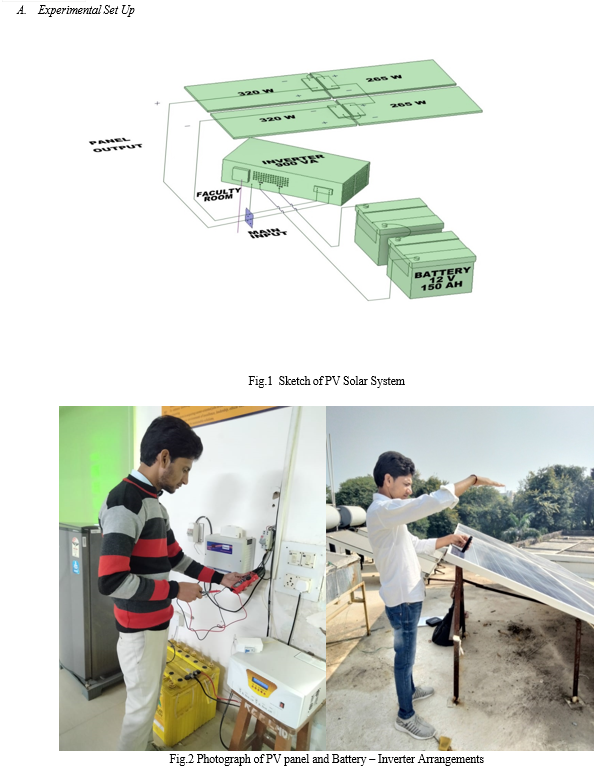
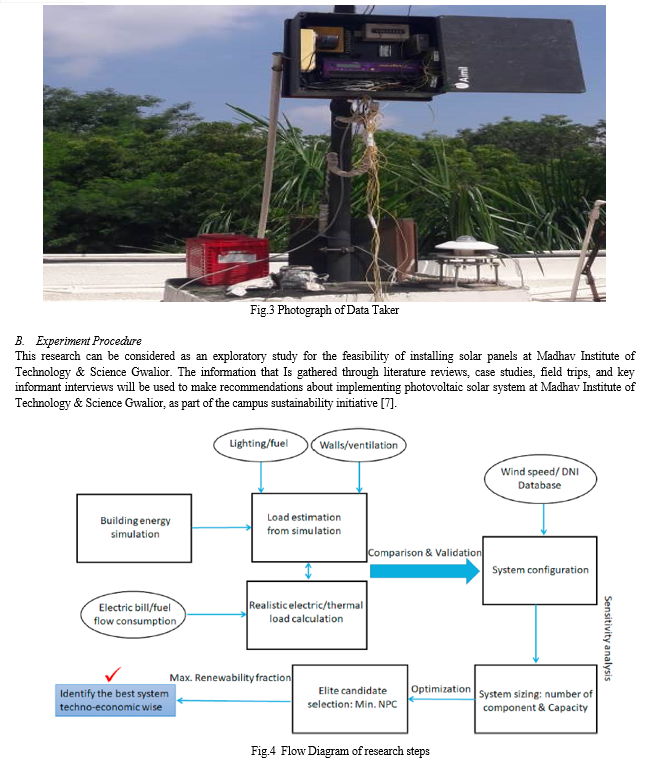
III. RESULTS AND DISCUSSION
This thesis can be considered as an exploratory study for the feasibility of installing solar panels at Madhav Institute of Technology & Science Gwalior. The information that is gathered through literature reviews, case studies, field trips, and key informant interviews will be used to make recommendations about implementing photovoltaic solar system for the campus sustainability initiative.
Several research techniques have been employed to ensure that sufficient information has been gathered to evaluate the feasibility of photovoltaic solar system at Madhav Institute of Technology & Science, Gwalior in terms of technological, economic, environmental, and social factors [8].
A. Load Calculation
There are two primary blocks for load calculations
- Six faculty rooms
- HOD cabin
The study began in earnest fashion on 28 Sep 2022 with the primary aim of to determine the load of all six faculty rooms and HOD cabin and find out the performance of off grid and on grid solar PV systems.
|
S No |
Date |
Block |
|
01 |
29/09/2022 |
Six Faculty Rooms |
|
02 |
30/09/2022 |
HOD Cabin |
Table 1 No of Blocks
B. Faculty Room Load Calculation
Six faculties room wise connected load has been calculated based on the electrical appliances (load) on each faculty room as under
|
S No |
Connected Load |
Wattage |
|
01 |
Fan Load (6 fans×60 W) |
360 W |
|
02 |
Light Load (6 LED × 9 W) |
54 W |
|
|
TOTAL |
414 W |
Table 2 Total loads of the faculty rooms
The annual energy consumption in kilowatt hour (electrical unit) for each faculty room has been calculated based on the above load, taking into consideration 6 working hours per day, 22 working days per month, and a total of 9 working months in a year.
|
S No |
Room wise load |
Electrical Consumption (kWh per Annum) |
|
Faculty Room 1
|
1 LED (9 W) + 1 FAN (60 W) = 69 Watt × 6 hours per day for 22 days in a month for 12 months |
110 KW |
|
Faculty Room 2
|
1 LED (9 W) + 1 FAN (60 W) = 69 Watt × 6 hours per day for 22 days in a month for 12 months |
110 KW |
|
Faculty Room 3
|
1 LED (9 W) + 1 FAN (60 W) = 69 Watt × 6 hours per day for 22 days in a month for 12 months |
110 KW |
|
Faculty Room 4
|
1 LED (9 W) + 1 FAN (60 W) = 69 Watt × 6 hours per day for 22 days in a month for 12 months |
110 KW |
|
Faculty Room 5
|
1 LED (9 W) + 1 FAN (60 W) = 69 Watt × 6 hours per day for 22 days in a month for 12 months |
110 KW |
|
Faculty Room 6
|
1 LED (9 W) + 1 FAN (60 W) = 69 Watt × 6 hours per day for 22 days in a month for 12 months |
110 KW |
|
|
Total |
660 KW |
Table 3 Electricity consumption of each faculty room of MITS College in Gwalior
- Estimation of kW rating of the system
The total load (energy requirement) of the system – i.e.
Total connected load of PV panel system = 414 watt
2. Total watt-hours rating of the system
= Total connected load (watt) × operating hours
= 414 × 6 = 2484 watt hours or (2.5 KWH)
3. Estimation of number of PV panels
Actual power output of a PV panel
= peak power rating × operating factor
= 320 × 0.90 = 288 watt
The power used at the end user is less (due to lower combined efficiency of the system)
= actual power output of a panel × combined efficiency
= 288 × 0.80 = 131 watt (VA)
Energy produced by one 320 watt PV panel in a day
= actual power output × 6 hour per day
= 231 × 6 = 1386 watt hour
Number of solar PV panels required to satisfy given estimation for daily load
= total watt hour rating per daily energy produced by panel
= 2484÷1386 = 2 panels of 320 WP
4. Estimation of inverter and batteries
Number of inverter requires are calculated as:-
Total connected load to PV
- Panel system = 414 watt
- Inverter with the rating of 900 VA is used
Therefore,
The number of inverter required are = 1
5. Number of batteries depends on the backup time required
Calculated the battery backup
Battery volt × battery AH rating × inverter efficiency / total watt on load
= 12 × 150 × 0.85 ÷ 414
= 3.69 hours
For 6 hours battery backup
2 × 150 Ah batteries are connected to inverter
6. Assumption taken for design
- Inverter convert to DC into AC power with efficiency of about 85%
- Battery voltage used for operation = 12 volt
- Combined efficiency of inverter and battery will be calculated as
Combined efficiency = PCU efficiency × battery efficiency
= 0.9 × 0.9 = 0.81 = 81%
- Sun light available in a day = 6 hours / day
- Operation of light and fan = 6 hours/ day
- PV panel power rating = 320 Wp
Where WP = watt peak
C. HOD Cabin Load Calculation
The MITS College in HOD cabin connected load has been calculated based on the electrical appliances (load) as under
|
S No. |
Connected load |
Wattage |
|
01 |
Light load (1 LED × 9W ) |
09 W |
|
02 |
Air Conditioner (1 AC × 800W ) |
800 W |
|
03 |
Fan load (2 Fans × 60W ) |
120 W |
|
|
Total |
929 W |
Table 4 Total loads of the HOD cabin
The annual energy consumption in kilowatt hour (electrical unit) for HOD cabin has been calculated based on the above load taking into consideration 6 working hours per day, 22 working days per month and a total of 9 working months in a year.
|
S No. |
HOD cabin |
Electrical consumption ( kWh per Annum ) |
|
01 |
1 LED (9 W) + 1 AC (800 W) + 2 Fans (60 W) = 929 Watt × 6 hours per day for 22 days in a month for 12 months. |
1471.536 KW
|
|
|
Total |
1472 KW (Approx.) |
Table 5 Electricity consumption of the HOD cabin of MITS College in Gwalior
- Estimation of kW rating of the system
The total load (energy requirement) of the system – i.e.
Total connected load of PV panel system = 929 watt
2. Total watt-hours rating of the system
= total connected load (watts) × operating hours
= 929 × 6 = 5574 watt hours or (5.5 KWH)
3. Estimation of Number of PV Panels
Actual power output of a PV panel
= peak power rating × operating factor
= 320 × 0.90 = 288 watt
The power used at the end user is less (due to lower combined efficiency of the system)
= actual power output of a panel × combined efficiency
= 288 × 0.80 = 231 watt (VA)
Energy produced by one 320 watt PV panel in a day
= 231 × 6 = 1386 watt-hours
Number of solar PV panel required to satisfy given estimation for daily loads
= total watt hours rating / daily energy produced by panels
= 5574 ÷ 1386
= 4.0216 panels or
= 5 panels (Approx.)
4. Assumption Taken for Design
- Sun light available in a day = 6 hours/day
- Operation of light, air conditioner and fan = 6 hours/day of PV panel
- PV panel power rating = 320 Wp
Where Wp = Watt-peak
After the load calculation and designing the PV panels, battery sizing, the data is collected
Throughout the day and results are analyzed. These data are collected two days in every month in
Between September to December 2022. Average data of these months are shown in tables.
|
Time |
Current (Amp) |
Voltage (V) |
Panel Surface Temperature (ºC) |
Solar Radiation (W/m2) |
|
|
Vertical |
Inclined |
||||
|
10:00 AM |
3.39 |
295 |
41.7 |
476 |
710 |
|
11:00 AM |
3.56 |
300 |
43 |
566 |
905 |
|
12:00 PM |
3.69 |
310 |
50.7 |
590 |
930 |
|
1:00 PM |
3.53 |
290 |
47 |
480 |
901 |
|
2:00 PM |
3.41 |
278 |
41.8 |
355 |
887 |
|
3:00 PM |
3.19 |
250 |
39 |
280 |
610 |
|
4:00 PM |
2.95 |
225 |
34 |
135 |
300 |
|
5:00 PM |
2.61 |
210 |
29 |
85 |
150 |
Table No. 6. Average Data collection of PV panels (Sept, 2022)
|
Time |
Illumination on the ground Surface |
Illumination on faculty Table |
Illumination on above faculty table |
|||||
|
On |
Off |
On |
Off |
On |
Off |
|||
|
10:00 AM |
160 |
110 |
200 |
150 |
300 |
210 |
||
|
11:00 AM |
190 |
130 |
240 |
180 |
330 |
230 |
||
|
12:00 PM |
200 |
160 |
260 |
210 |
350 |
270 |
||
|
1:00 PM |
113 |
95 |
232 |
200 |
321 |
275 |
||
|
2:00 PM |
90 |
53 |
165 |
110 |
172 |
85 |
||
|
3:00 PM |
59 |
25 |
119 |
57 |
110 |
41 |
||
|
4:00 PM |
41 |
15 |
78 |
33 |
74 |
23 |
||
|
5:00 PM |
29 |
11 |
42 |
14 |
45 |
15 |
||
Table No. 7 Average Data collection of Faculty Rooms (Sept,2022)
|
Time |
Current (Amp) |
Voltage (V)
|
Panel Surface Temperature (ºC) |
Solar Radiation (W/m2) |
|
|
Vertical |
Inclined |
||||
|
10:00 AM |
3.31 |
297 |
41.2 |
472 |
709 |
|
11:00 AM |
3.49 |
309 |
43.4 |
569 |
910 |
|
12:00 PM |
3.58 |
316 |
50.5 |
599 |
938 |
|
1:00 PM |
3.51 |
299 |
48 |
476 |
907 |
|
2:00 PM |
3.41 |
274 |
41 |
357 |
879 |
|
3:00 PM |
3.21 |
248 |
39.5 |
289 |
530 |
|
4:00 PM |
2.97 |
229 |
34.6 |
133 |
280 |
|
5:00 PM |
2.63 |
210 |
30 |
87 |
159 |
Table No. 8. Average Data collection of PV panels (Oct, 2022)
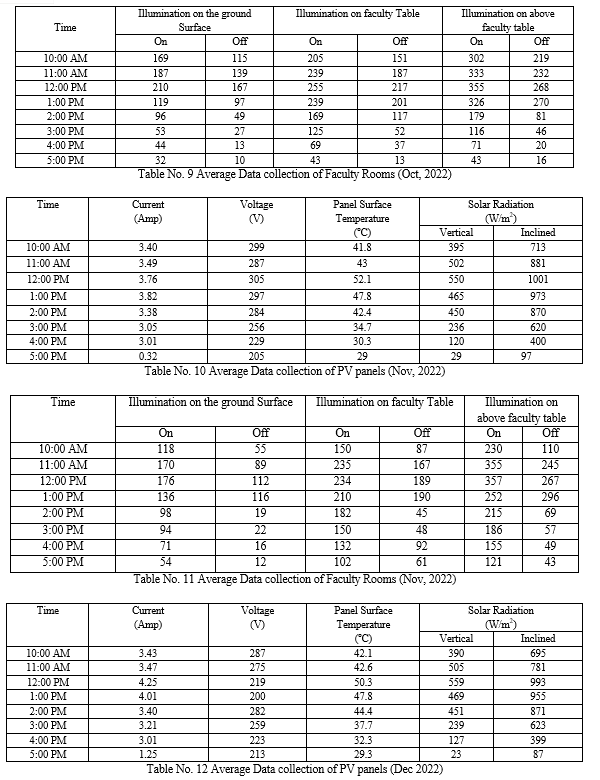
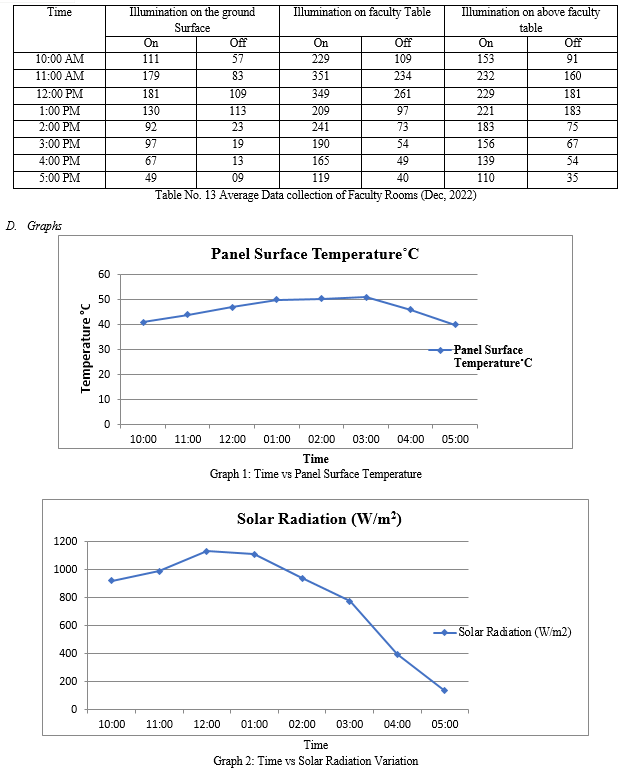
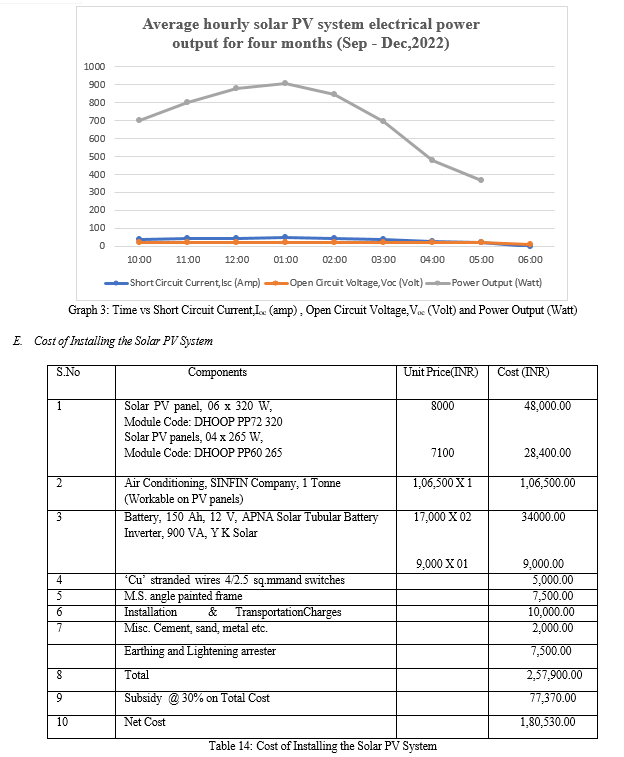
IV. DATA ANALYSIS AND RESULTS
From the load estimation, it is revealed that the connected load in the institution is 1343 watt hr. Hence, a solar PV system of 03 kW capacities has been proposed for installation
Ample roof space is available for installation of the solar panels. Hence, it is proposed to install solar PV Panels on the rooftops of the MITS, Gwalior.
The Grid power supply in the area is erratic with prolonged power cuts, hence an off-grid system has been recommended despite the higher cost of batteries and maintenance so as to ensure 24X7 power supply availability.
Capital investment by customer is Rs. 180,530.00/- which comes out to Rs 18,053 per kW. The unit rate of electricity generated by this college will be Rs. 1.80 per unit. Customer’s present rate of power is Rs. 7.60/- per unit which may increase substantially in 25years.
Solar photovoltaic systems have a high capital expense which makes it unviable for
Installation but includes several incentives to promote the same .
They are outlined as follows:
- According to JNNSM, for the year 2016-17, the benchmark price for photovoltaic systems with battery back-up support is considered as Rs.70/- per Wp
As the present conventional energy prices are relatively high, solar electricity systems are thus cost efficient to install in the long run. It is expected that the pricing structure of conventional energy will further increase in such a way that the economic viability of solar panel systems will further improve the future [9].
A. System Overview
|
S. No |
System Capacity of Solar PV |
03 kW System |
|
1 |
Brand Name: |
Panels: DHOOP, and Agrawal Group, Goa |
|
2 |
Type: |
Rooftop Off Grid System with batteries Rooftop On Grid System With Solar AC |
|
3 |
Weight & Area Required: |
The weight of the Solar system is@20kg/m2. Total load will be around 0.6 Tonn. The area required will be @30sq ft. /kW. Total shadow free area required will be around 300 sq. ft. For the total system of 03 kW. |
|
4 |
Mounting Structure: |
Panels shall be mounted on galvanized frames inclined at 28? to the south. The structure is designed in such a manner that module can be replaced easily and in line with site requirements and it is easy to Install and service in future. |
|
5 |
Energy Generation in kWhr: |
4,422 kWh (units) annually for a 03 kW system. |
|
6 |
Solar PV System Cost: |
Total Turnkey execution cost Rs. 1,80,530/- |
|
7 |
Benefits: |
Accelerated depreciation benefits.Government Subsidies for PV:30% of the System size. |
Table 15: System overview
B. Savings and Payback
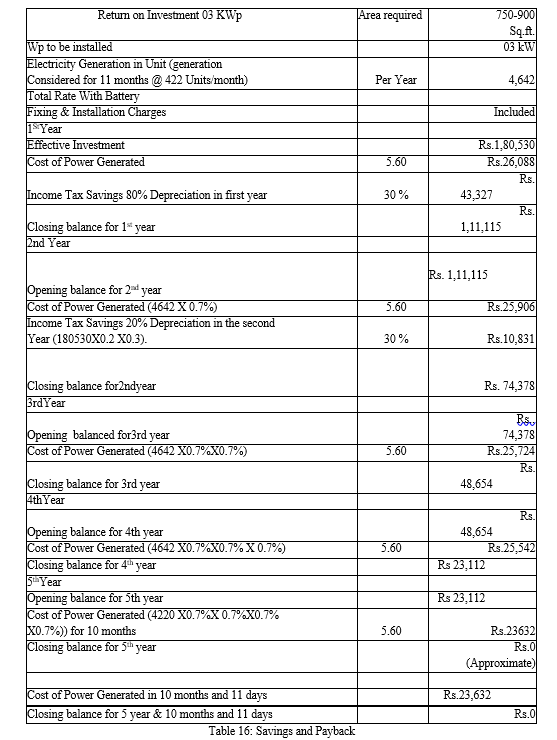
C. Thus ROI is Less than 6 Years as per the Above Calculations.
The total life of solar panel is more than 25 years; it will generate electricity for 25 years. The solar panel power output will decline annually by not more than 0.7% of the peak power. Hence power output at the end of 25 years will be at least 80 % of the peak power. In 25 years it will generate 1, 16,050 units of electricity.
With the subsidized capital costs and annual monetary savings as above, the overall
Payback period turns out to be 5 Years and 10 Months and 11days.
As a result, the financial viability of the project is extremely good.
V. ACKNOWLEDGMENTS
This work was supported by All India Council of Technical Education (AICTE), New Delhi for providing the fund through the RPS project (File No. 8-207/RIFD/RPS (Policy-1)/2018-19 dated 20.03.2020) to develop the experimental setup and carryout the experiment.
Conclusion
In this work, the dynamic performance of the grid-tied battery backup system was analyzed to follow residual power fluctuations. The goal of this research was to develop a design system to help end-users identify the best investment decision and system size for their specific applications. With the use of PV system maximize saving of electricity bill. The model is capable of identifying the feasibility of investment in PV battery systems and the specifications of the optimal system. In this design, the LiFePO4 battery offers more with high power applications. In this designed system, the round trip efficiency of the battery contributes to increasing the overall system efficiency by 2%. To this effect, the solar global horizontal irradiance (GHI) of the premises was monitored to interrogate the performance of the PV system with respect to the occupants\' daily activities. Parameters such as the voltages and currents of the PV array and batteries as well as the demand and energy consumption of the mechanical wing were monitored continuously. These parameters were used to compute the daily supply and cumulative energy of the PV array and batteries, which represented the PV system performance. The impact of the occupants’ activities on the performance of the system was also taking into consideration. 1) The results of the study which only involves the PV performance on Sept-Dec 2022 show a maximum solar radiation was found 1001.05 W/m2. 2) The average PV supply rate was for faculty room 2484 watt-hr and 2.5 Kwh while in HOD cabin 5574 watt-hr 5.5 kWh. 3) It also generates an average morning and evening peaks demand of 1.18 kW and 1.32 kW, respectively. 4) The PV system was also found to continuously power the mechanical wing irrespective of the sky condition during the weekends. However, on a cloudy weekday, the load was disconnected from the PV system during the evening demand period due to low battery power. Therefore, the design system can provide reliable energy access to mechanical wing. a) The payback time of the system found 5 years 10 months. b) Illumination found better in faculty rooms as compared to grid connected transformers.
References
[1] Dondariya, C.; Porwal, D.; Awasthi, A.; Shukla, A.K.; Bhimte, A. Performance simulation of grid?connected rooftop solar PV system for small households: A case study of Ujjain, India. Energy Rep. 2018, 4, 546–553. [2] Neha Bansal, Shiva Pujan Jaiswal, Gajendra Singh. Comparative investigation of performance evaluation, degradation causes, impact and corrective measures for ground mount and rooftop solar PV plants – A review Sustainable Energy Technologies and Assessments 47 (2021) 101526. [3] Ochuko K. Overen and Edson L. Meyer Performance Analysis of a Stand-alone Building Integrated Photovoltaic System International Conference on Solar Heating and Cooling for Buildings and Industry 2019. [4] Jonas Manuel Gremmelspacher, Rafael Campam`a Pizarro, Matthijs van Jaarsveld, Henrik Davidsson, Dennis Johansson Historical building renovation and PV optimization towards NetZEB in Sweden Solar Energy 223 (2021) 248–260. [5] G.K. Mishra, G.N. Tiwari, T.S. Bhatti, Effect of water flow on performance of building integrated semi-transparent photovoltaic thermal system: a comparative study, Sol. Energy 174 (2018) 248e262. [6] Wei Wu, Harrison M. Skye?, Piotr A. Domanski. Selecting HVAC systems to achieve comfortable and cost-effective Applied Energy 212 (2018) 577–591. [7] Simone Ferrari , carlo Romeo. Retrofitting under protection constraints according to the nearly Zero Energy Building (nZEB) target: the case of an Italian cultural heritages school building. Energy Procedia 140 (2017) 495–505. [8] Jain, M., Hoppe, T., Bressers, J., 2014. Introducing the Sectoral System Innovation Framework (SSIf) for Assessment of Niche Development on Net ZeroEnergy Buildings in India. Netherlands Institute of Governments, Delft.Kemp, R., Schot, e. a., 1998. Regime shifts to sustainablilty through processes of niche formation: the approach of strategic niche management. Technol.Anal. Strat. Manag., 175–196. [9] Paula Kivimaaa,b,, Eeva Primmera, Jani Lukkarinena Intermediating poransitions toards net-zero energy buildings. Environmental Innovation and Societal Transitions Volume 36, September 2020, Pages 418-432.
Copyright
Copyright © 2023 Ravindra Jatav , Amit Shrivastava, Prof. R. K. Pandit. This is an open access article distributed under the Creative Commons Attribution License, which permits unrestricted use, distribution, and reproduction in any medium, provided the original work is properly cited.

Download Paper
Paper Id : IJRASET48925
Publish Date : 2023-01-30
ISSN : 2321-9653
Publisher Name : IJRASET
DOI Link : Click Here
 Submit Paper Online
Submit Paper Online

